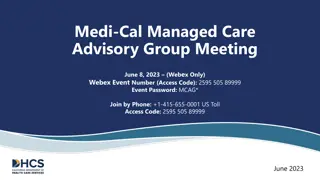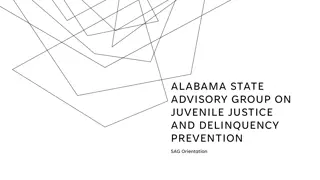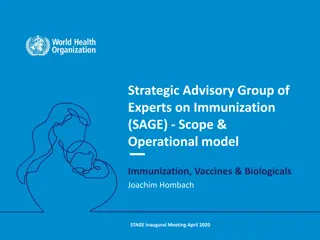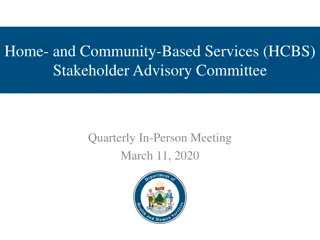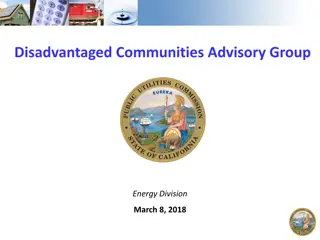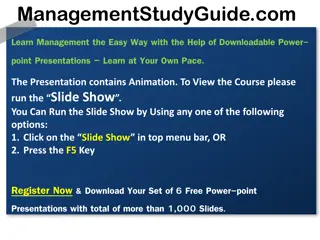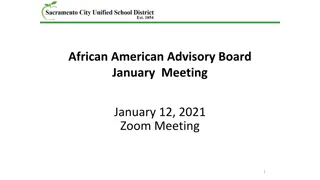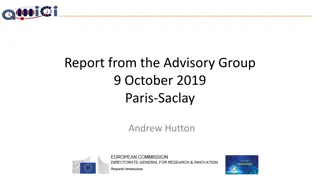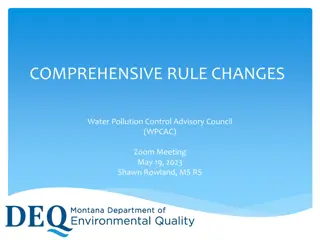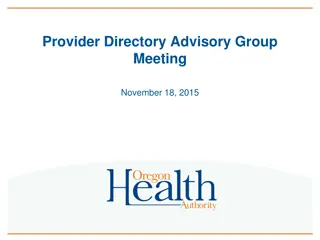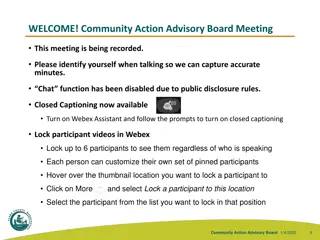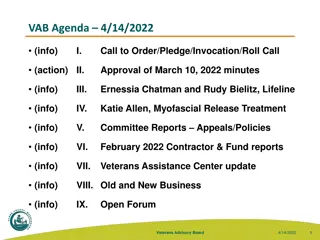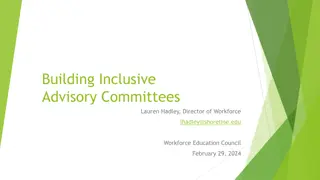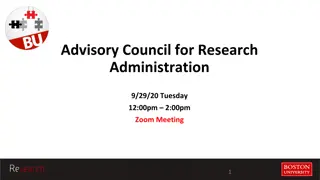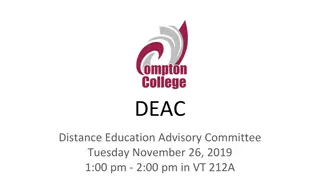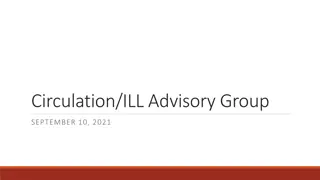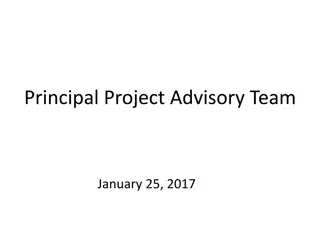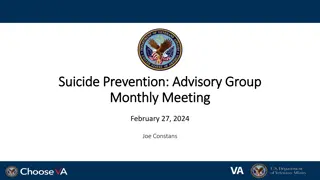Community Benefits Advisory Group Meeting Highlights & Key Discussions
The Community Benefits Advisory Group met on March 10th, 2023, discussing important topics such as land acknowledgements, group introductions, terms of reference, updates from working groups, community benefits toolkit, and more. The meeting also addressed key issues like outreach strategies, achieving hiring objectives, data tracking, setting targets, and engaging with community partners and stakeholders for impactful collaboration towards community benefits.
Download Presentation

Please find below an Image/Link to download the presentation.
The content on the website is provided AS IS for your information and personal use only. It may not be sold, licensed, or shared on other websites without obtaining consent from the author. Download presentation by click this link. If you encounter any issues during the download, it is possible that the publisher has removed the file from their server.
E N D
Presentation Transcript
Community Benefits Advisory Group March 10th, 2023 1
Agenda 1. Welcome 2. Land & African Ancestral Acknowledgements 3. Advisory Group Introductions & Updates 4. CB Advisory Group Terms of Reference (TOR) 5. Updates from Ad Hoc Working Groups 6. Community Benefits Toolkit and Pilot Testing 7. Discussion 8. Meeting Adjourn 2
Land & African Ancestral Acknowledgements Land acknowledgement "We acknowledge the land we are meeting on is the traditional territory of many nations including the Mississaugas of the Credit, the Anishnabeg, the Chippewa, the Haudenosaunee and the Wendat peoples and is now home to many diverse First Nations, Inuit and Metis peoples. We also acknowledge that Toronto is covered by Treaty 13 with the Mississaugas of the Credit" African Ancestral Acknowledgement "The City of Toronto acknowledges all Treaty peoples including those who came here as settlers as migrants either in this generation or in generations past and those who came here involuntarily, particularly those brought to these lands as a result of the Trans-Atlantic Slave Trade and Slavery. We pay tribute to those ancestors of African origin and descent." 3
Advisory Group Introductions Welcome back Please introduce yourself (name, organization) 4
Recap Meeting 1: February 25, 2022 See link to meeting presentation 5
Recap: Key Issues and Challenges Recap: Key Issues and Challenges Outreach and recruitment strategies that connect employers with Black, Indigenous and equity-seeking communities Achieve community benefits hiring objectives in coordination with skilled trade unions Data tracking and reporting for compliance Setting hard targets that are specific, ambitious and achievable Coordinated systems approaches to hiring pathways and social procurement 6
Recap: Community Partners & Key Recap: Community Partners & Key Stakeholders Stakeholders Community partners and key stakeholders have expertise and capacity that the City can leverage, as opposed to doing it alone Eco-system Players Anchor institutions such as colleges, universities and hospitals Black (led, serving, focused) organizations Businesses (local and diverse-owned) City divisions, agencies and corporations Colleges and universities Community organizations Contractor Contractor Associations Developers Employers Employment service providers Grant makers Indigenous (led, serving, focused) Social enterprises Training centres Unions 7
Community Benefits Advisory Group Terms of Reference To bring together knowledge and experiences of strategic partners to collaboratively problem solve key issues and challenges related to City s Community Benefits Framework Purpose Social and economic inclusion Guiding Principles Engagement with strategic partners is vital Systems approach to collaboration and joint problem solving 1 representative at Community Benefits Advisory Group Up to 2 representatives at each Ad Hoc Working Group Ad Hoc Working Groups 8
CB Advisory Group Feedback Survey Summary of Findings CheckMarket online survey (January 24th February 7th, 2023) 56% response rate (33 out of 59 total respondents) Respondents reported: Overall agreement to continue with the Advisory Group's current mandate and goals Satisfaction with the current frequency and duration of meetings (twice a year; 2- hour meetings) Stakeholder engagement and collaboration is what the group is "doing right to advance the agenda of community benefits" Respondents suggested: Vision/mission/mandate of the CB team should be clear CB team should set realistic/attainable goals in their work 9
Questions 10
Ad Hoc Working Group 1: Community Benefits Hiring, Recruitment and Retention 11
Working Group 1 Deliverables Working Group 1 Deliverables Deliverable 1: Hiring Pathways Deliverable 2: Hiring Forecast & Employer Engagement Deliverable 3: Partnership Models Q4 2022 Validation and Feasibility Consultations Group meetings: City Leads Table, Working Group 1, Service Providers Network Small groups and one on one meetings: CB ecosystem members and stakeholders (e.g., developers, contractors, ESPs, community organizations and members, City divisional leads and project leads/managers, etc.) 12
Deliverable 1: Hiring Pathways Key Activities Develop current state journey maps on employment in construction and customized recruitment Identify barriers faced and the training and supports required to overcome pain points throughout journey Develop desired future state path for jobseekers Identify critical steps to enable job readiness and roles and responsibilities of partners Launch and test minimum viable product (MVP) of desired path March 2023 update: Deliverable 1 complete Tools developed: Journey maps, process flows, and reports on hiring pathways and community benefits ecosystem 13
Deliverable 2: Hiring Forecast & Employer Engagement Key Activities: Develop approach to forecast hiring needs for existing contracts and agreements Determine critical information needed in forecast to inform planning to prepare and place jobseekers Develop employer engagement plan to ensure active participation from contractors and businesses Develop guidelines on how to connect community to these opportunities March 2023 update Tools developed: PAT labour forecasting template, community benefits project specific working group (CBPSWG), guidelines to connect employers with ESPs PAT Labour forecast template was completed by an experienced awarded contract holder during feasibility and validation period for examination, evaluation and feedback Next steps: Pilot and refine the above tools 14
Deliverable 3: Partnership Models Key Activities: Identify and scope key components of models Identify and apply best practices to shape components of models Identify core elements for partnership agreements Launch and test models March 2023 update Tools developed: workforce intermediary, tiered approach, community benefits project specific working group (CBPSWG) Next steps: Pilot and refine the above tools, and draft roles RACI (responsible, accountable, consulted, informed) chart for every CB initiative (E.g. Social Procurement Program) 15
Ad Hoc Working Group 2: Community Benefits Hiring with Skilled Trades Unions 16
Roadmap Working Group 2 Deliverable 1: Labour Forecasting Deliverable 2: Collecting and Tracking Data on Equity Indicators Deliverable 3: Best practices, approaches and mechanisms for reporting on construction hiring targets 17
Updates Working Group 2 Deliverable 1: Labour forecasting Labour Forecasting Template currently being piloted on City project Deliverable 2: Collecting and tracking data on equity indicators Collaboration with LiUNA 506 Training Centre on piloting processes that ensure Indigenous, Black and equity-deserving communities are represented on City of Toronto construction projects that require LiUNA labour Deliverable 3: Best practices, approaches and mechanisms for reporting on construction hiring targets Currently developing draft of construction hiring implementation process 18
Ad Hoc Working Group 3: Community Benefits Workforce Development Monitoring and Evaluation (M&E) 19
Working Group 3: Roadmap Deliverable 1 Launch of Community Benefits Ad Hoc Working Group on Monitoring and Evaluation (2021) Deliverable 2 Develop the Community Benefits Workforce Development Theory of Change (2022) Deliverable 3 Develop the key elements of the monitoring and evaluation framework (2022/2023) Deliverable 4 Develop, test and refine data collection and reporting tools (2023/2024) 20
Working Group 3: Steps along our roadmap Why? What? When? How? Who? Develop Community Benefits Workforce Development Theory of Change Define monitoring and evaluation purpose and primary users Define key guiding monitoring and evaluation questions Craft performance measures Define data sources, data collection methods, reporting, role and timelines Craft and test data collection and reporting tools 21
Key learnings and principles Monitoring and evaluation is a shared responsibility among Community Benefits partners an integral part of the Community Benefits implementation more than measuring the achievements of targets about telling a story Monitoring and evaluation is not about auditing, but about providing insights and generating knowledge about a "Gotcha!" 22
Pilot testing: Community Benefits Toolkit Templates and guidelines Community benefits glossary, terms and definitions Project assessment guide Labour forecasting templates for PAT hiring (Professional, Administrative, Technical) and construction hiring Guidelines to connect employers (contract holders) with employment service providers New models and approaches Workforce intermediary approach, roles and responsibilities Project Specific Working Group approach, roles and responsibilities Equity data pilot project with LiUNA 506 Monitoring and evaluation Monitoring and evaluation framework, includes outcomes and indicators, data tracking tools and reporting templates Includes processes for tracking and reporting construction hiring targets (%) 23
Pilot testing opportunities and risks Increased coordination, communication and clarity on the how Provides concrete how-to tools & processes to maximize community benefits outcomes in City projects Each pilot project has dedicated CB Workforce Intermediary to coordinate and communicate among stakeholders Enhanced CB data tracking, reporting, and analytics in real time Enhanced communication and structure among all stakeholders (contract holders, employers (engineering and design firms, contractors, developers), unions, employment service providers, community, training programs) CB toolkit is new and requires change management Staffing resources and dedicated time 24
Discussion Our asks 1. Spread the word on the CB toolkit 2. Identify employers (general contractors, sub-contractors, engineering and design, developers ) to help us validate and review CB toolkit 3. Highlight other CB models and tools we may have missed 25




